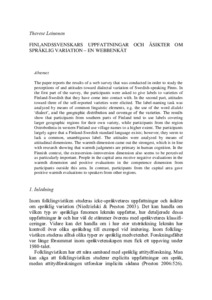Finlandssvenskars uppfattningar och åsikter om språklig variation – En webbenkät
Therese Leinonen
https://urn.fi/URN:NBN:fi-fe2021042714516
Tiivistelmä
The paper reports the results of a web survey that was conducted in order to study the perceptions of and attitudes toward dialectal variation of Swedish-speaking Finns. In the first part of the survey, the participants were asked to give labels to varieties of Finland-Swedish that they have come into contact with. In the second part, attitudes toward three of the self-reported varieties were elicited. The label-naming task was analyzed by means of common linguistic elements, e.g. the use of the word dialekt ‘dialect’, and the geographic distribution and coverage of the varieties. The results show that participants from southern parts of Finland tend to use labels covering larger geographic regions for their own variety, while participants from the region Ostrobothnia in western Finland use village names to a higher extent. The participants largely agree that a Finland-Swedish standard language exists; however, they seem to lack a common, unambiguous label. The attitudes were analyzed by means of attitudinal dimensions. The warmth dimension came out the strongest, which is in line with research showing that warmth judgments are primary in human cognition. In the Finnish context, the extraversion–introversion dimension also seems to be perceived as particularly important. People in the capital area receive negative evaluations in the warmth dimension and positive evaluations in the competence dimension from participants outside this area. In contrast, participants from the capital area gave positive warmth evaluations to speakers from other regions.
Kokoelmat
- Rinnakkaistallenteet [27094]
